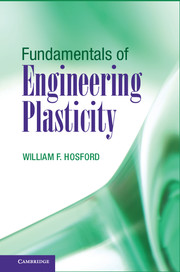Book contents
- Frontmatter
- Contents
- Preface
- 1 An Overview of the History of Plasticity Theory
- 2 Yielding
- 3 Stress and Strain
- 4 Isotropic Yield Criteria
- 5 Bounding Theorems and Work Principles
- 6 Slip-Line Field Theory
- 7 Anisotropic Plasticity
- 8 Slip and Dislocations
- 9 Taylor and Bishop and Hill Models
- 10 Pencil Glide Calculations of Yield Loci
- 11 Mechanical Twinning and Martensitic Shear
- 12 Effects of Strain Hardening and Strain-Rate Dependence
- 13 Defect Analysis
- 14 Effects of Pressure and Sign of Stress State
- 15 Lower-Bound Models
- 16 Plasticity Tests
- Index
- References
14 - Effects of Pressure and Sign of Stress State
Published online by Cambridge University Press: 05 June 2013
- Frontmatter
- Contents
- Preface
- 1 An Overview of the History of Plasticity Theory
- 2 Yielding
- 3 Stress and Strain
- 4 Isotropic Yield Criteria
- 5 Bounding Theorems and Work Principles
- 6 Slip-Line Field Theory
- 7 Anisotropic Plasticity
- 8 Slip and Dislocations
- 9 Taylor and Bishop and Hill Models
- 10 Pencil Glide Calculations of Yield Loci
- 11 Mechanical Twinning and Martensitic Shear
- 12 Effects of Strain Hardening and Strain-Rate Dependence
- 13 Defect Analysis
- 14 Effects of Pressure and Sign of Stress State
- 15 Lower-Bound Models
- 16 Plasticity Tests
- Index
- References
Summary
The effects of pressure on the yield locus can be confused with the effects of the sign of the stress. For example, twinning is sensitive to the sign of the applied stresses and causes the yield behavior under compression to be different from that under tension.
S-D EFFECT
With a so-called strength differential (SD) effect in high strength steels [1], yield strengths under tension are lower than under compression. The fractional magnitude of the effect, 2(|σc| – σT)∕[(|σc| + σT] is between 0.10 and 0.20. Figure 14.1 shows the effect in an AISI 4330 steel and Figure 14.2 indicates that it is a pressure effect.
Although the flow rules, equation 4.18, predict a volume increase with yielding, none has been observed.
POLYMERS
For polymers, the stress-strain curves in compression and tension can be quite different. Figures 14.3 and 14.4 are stress strain curves for epoxy and PMMA in tension and compression. Figure 14.5 compares the yield strengths of polycarbonate as tested in tension, shear and compression. The effect of pressure on the yield strength of PMMA is plotted in Figure 14.6.
- Type
- Chapter
- Information
- Fundamentals of Engineering Plasticity , pp. 225 - 236Publisher: Cambridge University PressPrint publication year: 2013



